Stereoselective Copolymerization of Styrene with Terpenes Catalyzed by an Ansa-Lanthanidocene Catalyst: Access to New Syndiotactic Polystyrene-Based Materials
Abstract
:1. Introduction
2. Results and Discussion
2.1. Homopolymerization of Myrcene and Farnesene
2.2. Copolymerizations of Styrene with β-Myrcene and Farnesene
2.3. Terpolymerizations of Styrene with β-Myrcene and Ethylene
3. Materials and Methods
4. Conclusions
Supplementary Materials
Acknowledgments
Author Contributions
Conflicts of Interest
References and Notes
- Behr, A.; Johnen, L. Myrcene as a natural base chemical in sustainable chemistry: A critical review. ChemSusChem 2009, 2, 1072–1095. [Google Scholar] [PubMed]
- Loughmari, S.; Hafid, A.; Bouazza, A.; El Bouadili, A.; Zinck, P.; Visseaux, M. Highly stereoselective coordination polymerization of β-myrcene from a lanthanide-based catalyst: Access to bio-sourced elastomers. J. Polym. Sci. Part A Polym. Chem. 2012, 50, 2898–2905. [Google Scholar]
- Díaz de León Gómez, R.E.; Enríquez-Medrano, F.J.; Maldonado Textle, H.; Mendoza Carrizales, R.; Reyes Acosta, K.; López González, H.R.; Olivares Romero, J.L.; Lugo Uribe, L.E. Synthesis and characterization of high cis-polymyrcene using neodymium-based catalysts. Can. J. Chem. Eng. 2016, 94, 823–832. [Google Scholar]
- Liu, B.; Li, L.; Sun, G.; Liu, D.; Li, S.; Cui, D. Isoselective 3,4-(co)polymerization of bio-renewable myrcene using NSN-ligated rare-earth metal precursor: An approach to a new elastomer. Chem. Commun. 2015, 51, 1039–1041. [Google Scholar] [CrossRef] [PubMed]
- Liu, B.; Han, B.; Zhang, C.; Li, S.; Sun, G.; Cui, D. Renewable β-myrcene polymerization initiated by lutetium alkyl complexes ligated by imidophosphonamido ligand. Chin. J. Polym. Sci. 2015, 33, 792–796. [Google Scholar]
- Raynaud, J.; Wu, J.Y.; Ritter, T. Iron-catalyzed polymerization of isoprene and other 1,3-dienes. Angew. Chem. Int. Ed. 2012, 51, 11805–11808. [Google Scholar] [CrossRef] [PubMed]
- Schellenberg, J. Syndiotactic Polystyrene: Synthesis, Characterization, Processing, and Applications; John Wiley & Sons: Hoboken, NJ, USA, 2010. [Google Scholar]
- Malanga, M. Syndiotactic polystyrene materials. Adv. Mater. 2000, 12, 1869–1872. [Google Scholar]
- Zinck, P.; Bonnet, F.; Mortreux, A.; Visseaux, M. Functionalization of syndiotactic polystyrene. Prog. Polym. Sci. 2009, 34, 369–392. [Google Scholar]
- Jaymand, M. Recent progress in the chemical modification of syndiotactic polystyrene. Polym. Chem. 2014, 5, 2663–2690. [Google Scholar]
- Laur, E.; Kirillov, E.; Carpentier, J.-F. Engineering of syndiotactic and isotactic polystyrene-based copolymers via stereoselective catalytic polymerization. Molecules 2017, 22, 594. [Google Scholar]
- Quirk, R.P.; Huang, T.-L. Alkyllithium-initiated polymerization of myrcene: New block copolymers of styrene and myrcene. In New Monomers and Polymers; Polymer Science and Technology; Culbertson, B.M., Pittman, C.U., Jr., Eds.; Springer: Boston, MA, USA, 1984; Volume 25, pp. 329–355. [Google Scholar]
- Sarkar, P.; Bhowmick, A.K. Terpene based sustainable elastomer for low rolling resistance and improved wet grip application: Synthesis, characterization and properties of poly(styrene-co-myrcene). ACS Sustain. Chem. Eng. 2016, 4, 5462–5474. [Google Scholar] [CrossRef]
- Métafiot, A.; Kanawati, Y.; Gérard, J.-F.; Defoort, B.; Marić, M. Synthesis of β-myrcene-based polymers and styrene block and statistical copolymers by SG1 nitroxide-mediated controlled radical polymerization. Macromolecules 2017, 50, 3101–3120. [Google Scholar] [CrossRef]
- Georges, S.; Touré, A.O.; Visseaux, M.; Zinck, P. Coordinative chain transfer copolymerization and terpolymerization of conjugated dienes. Macromolecules 2014, 47, 4538–4547. [Google Scholar] [CrossRef]
- Laur, E.; Louyriac, E.; Dorcet, V.; Welle, A.; Vantomme, A.; Miserque, O.; Brusson, J.-M.; Maron, L.; Carpentier, J.-F.; Kirillov, E. Substitution effects in highly syndioselective styrene polymerization catalysts based on single-component allyl ansa-lanthanidocenes: An experimental and theoretical study. Macromolecules 2017, 50, 6539–6551. [Google Scholar]
- Rodrigues, A.-S.; Kirillov, E.; Vuillemin, B.; Razavi, A.; Carpentier, J.-F. Stereocontrolled Styrene–isoprene copolymerization and styrene–ethylene–isoprene terpolymerization with a single-component allyl ansa-neodymocene catalyst. Polymer 2008, 49, 2039–2045. [Google Scholar] [CrossRef]
- Georges, S.; Bria, M.; Zinck, P.; Visseaux, M. Polymyrcene microstructure revisited from precise high-field nuclear magnetic resonance analysis. Polymer 2014, 55, 3869–3878. [Google Scholar] [CrossRef]
- Newmark, R.A.; Majumdar, R.N. 13C-NMR spectra of cis-polymyrcene and cis-polyfarnesene. J. Polym. Sci. Part A Polym. Chem. 1988, 26, 71–77. [Google Scholar]
- Fineman, M.; Ross, S.D. Linear method for determining monomer reactivity ratios in copolymerization. J. Polym. Sci. 1950, 5, 259–262. [Google Scholar] [CrossRef]
- Due to the fact that the ratio of α/β isomers of farnesene in the monomer was not exactly known and that only the β-isomer was polymerized, the reactivity ratios related to the styrene-farnesene copolymerization could not be determined.
- Tan, R.; Guo, F.; Li, Y. Copolymerization of propylene with styrene and ethylene by a THF-containing half-sandwich scandium catalyst: Efficient synthesis of polyolefins with a controllable styrene content. Polym. Chem. 2017, 4, 482–489. [Google Scholar] [CrossRef]
- Li, X.; Hou, Z. Scandium-catalyzed copolymerization of ethylene with dicyclopentadiene and terpolymerization of ethylene, dicyclopentadiene, and styrene. Macromolecules 2005, 38, 6767–6769. [Google Scholar]
- Guo, F.; Nishiura, M.; Koshino, H.; Hou, Z. Cycloterpolymerization of 1,6-heptadiene with ethylene and styrene catalyzed by a THF-free half-sandwich scandium complex. Macromolecules 2011, 44, 2400–2403. [Google Scholar] [CrossRef]
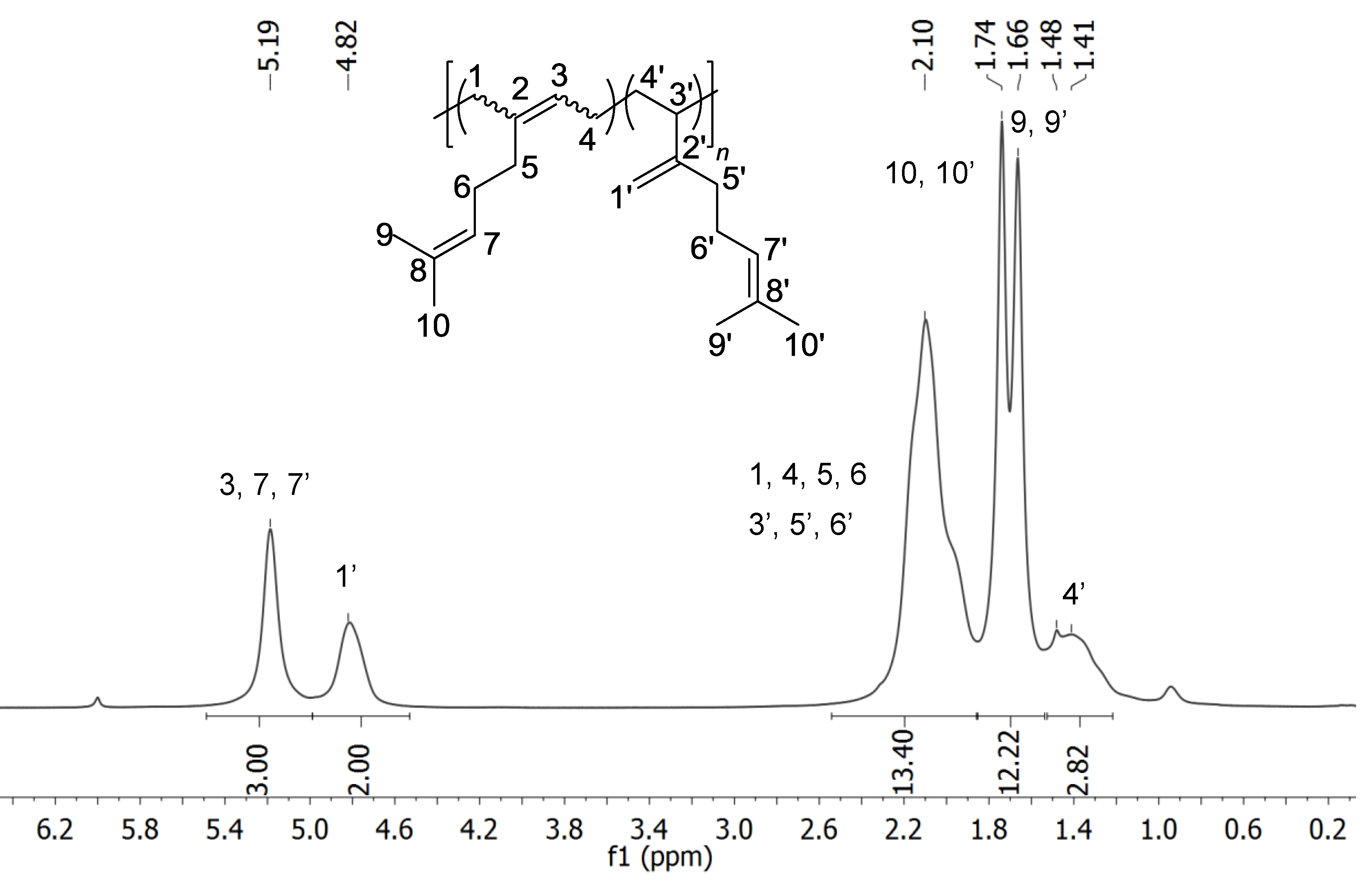
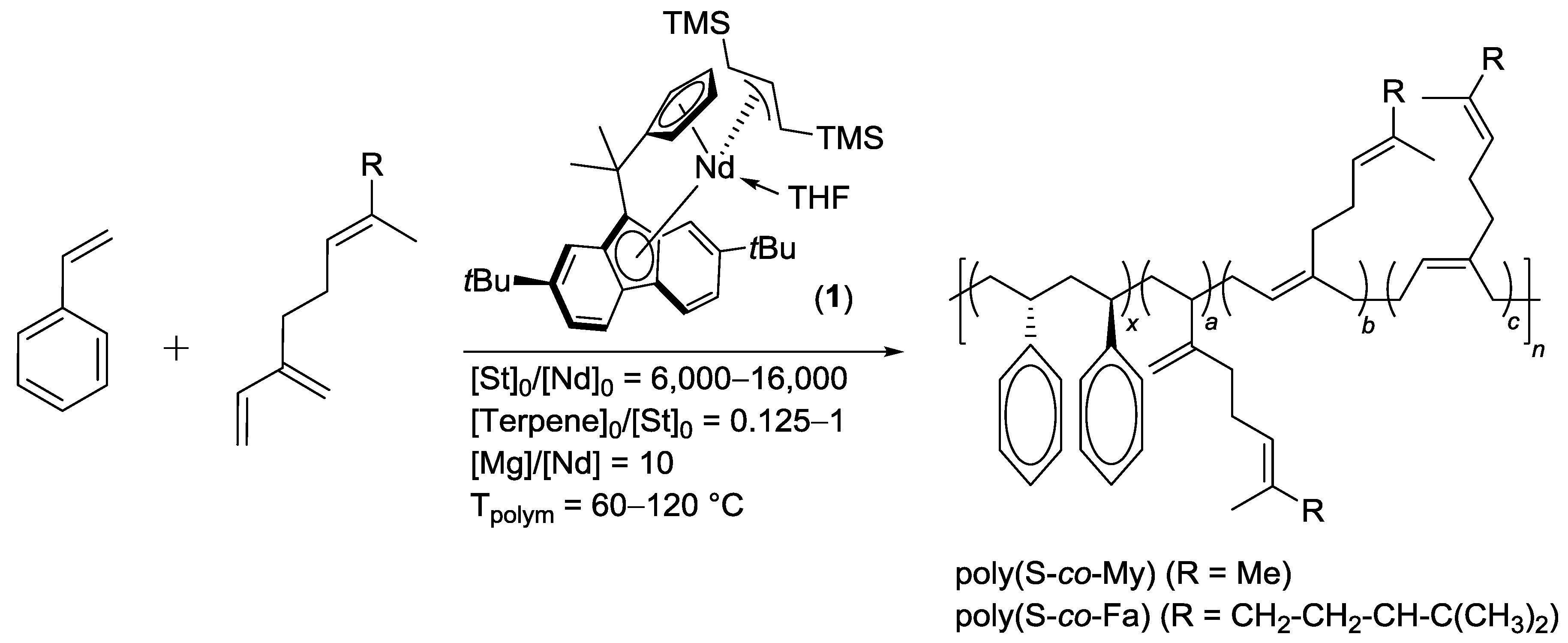
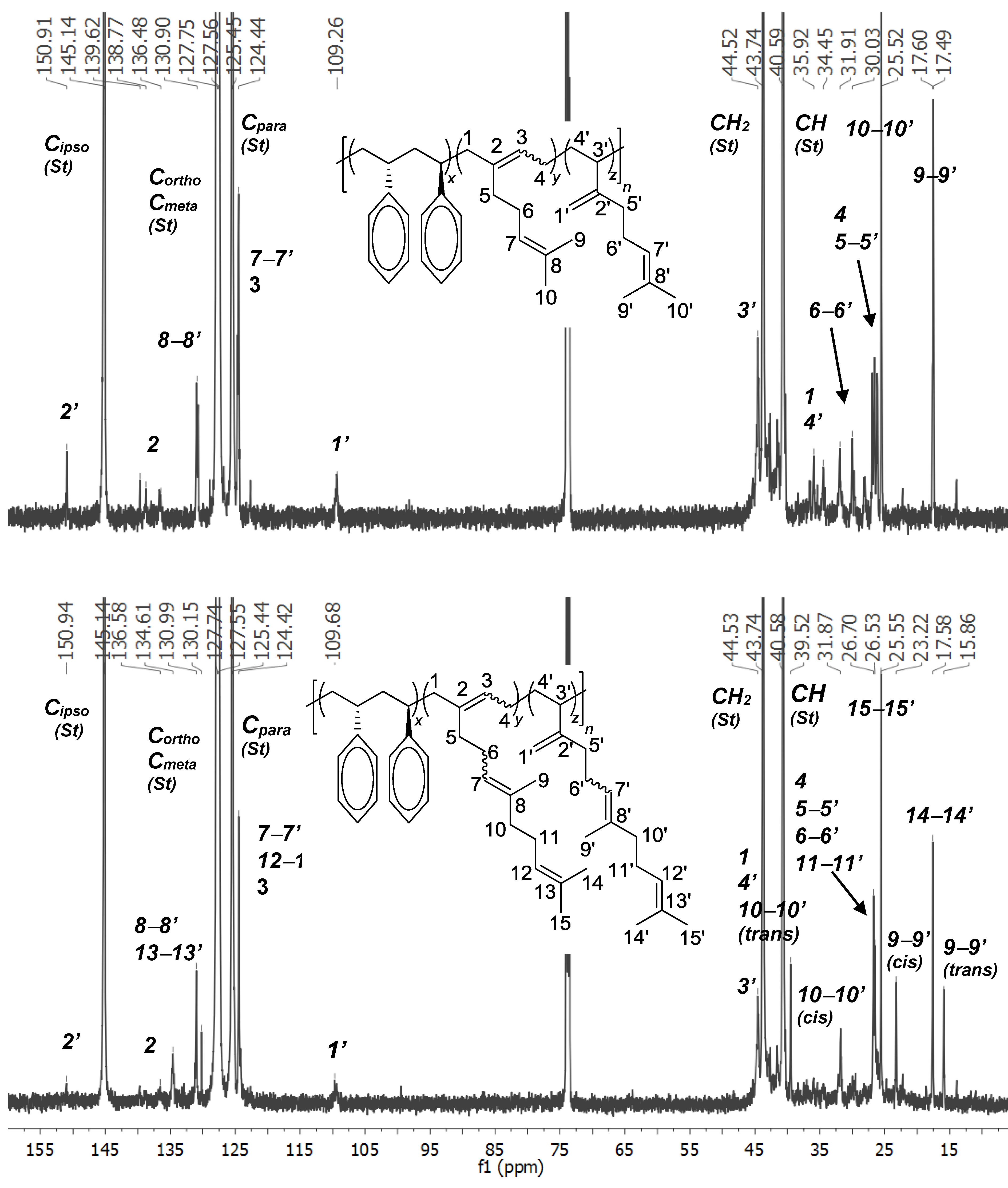
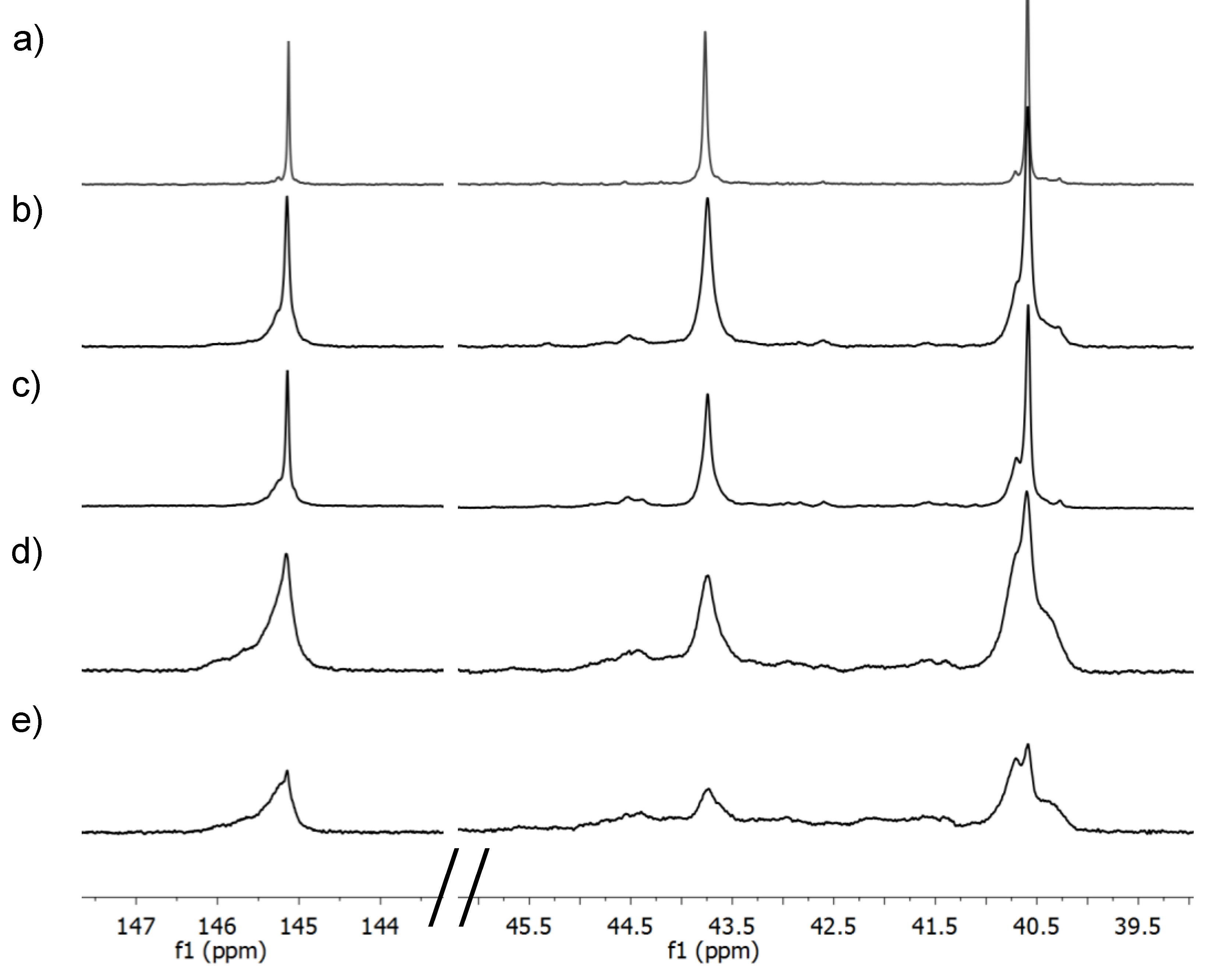
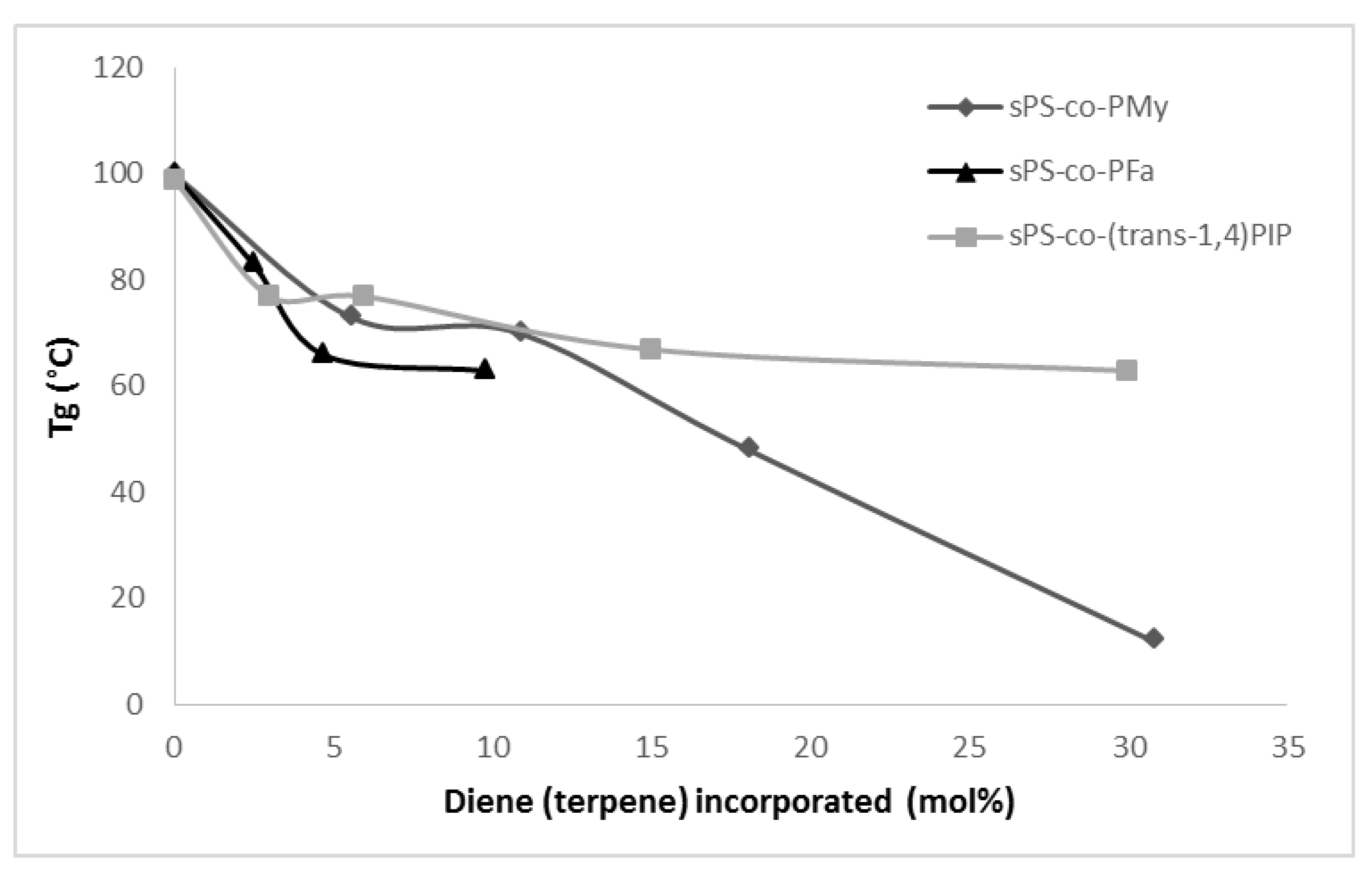

| Entry | Comonomer | [St]0 [M] | [St]0/[Nd] | [Comon]0/[St]0 | Tpolym [°C] | Time [min] | Prod. b [kg·mol−1·h−1] | Conv. St [%] | Conv. Comon [%] | Comon. Inc. c [mol %] | Tm d [°C] | Tc d [°C] | Tg d [°C] | ∆Hm d [J·g−1] | Mn × 10−3 [g·mol−1] e | ÐM e |
|---|---|---|---|---|---|---|---|---|---|---|---|---|---|---|---|---|
| 1 f | My | - | 0 | ∞ | 60 | 1320 | 0.74 | - | 11.6 | 100 | no | no | −58 | no | 3.87 | 1.33 |
| 2 f | My | - | 0 | ∞ | 120 | 1320 | 5.0 | - | 78.8 | 100 | no | no | −44 | no | 5.43 | 1.53 |
| 3 | - | 4.4 | 8000 | 0 | 60 | 120 | 248 | 60 | - | 0 | 251,265 | 231 | 100 | 30.0 | 22.6 k | 2.5 k |
| 4 | My | 4.4 | 8000 | 0.125 | 60 | 120 | 127 | 28.2 | 13.1 | 5.6 | 208,226 | 176 | 73 | 14.4 | 23.2 | 1.8 |
| 5 g | My | 4.4 | 16,000 | 0.125 | 60 | 120 | 114 | 12.6 | 6.2 | 5.7 | 220,235 | 187 | 78 | 20.4 | 26.8 | 1.4 |
| 6 | My | 4.4 | 8000 | 0.25 | 60 | 120 | 56 | 11.6 | 5.7 | 10.9 | 206 | 156 | 70 | 9.9 | 25.1 | 1.3 |
| 7 h | My | 4.4 | 20,000 | 0.25 | 120 | 120 | 374 | 27.1 | 26.7 | 19.7 g | no | no | 45 | no | 30.3 | 1.8 |
| 8 | My | 4.4 | 8000 | 0.5 | 60 | 180 | 20 | 5.4 | 2.4 | 18.1 | no | no | 48 | no | 36.6 | 2.7 |
| 9 i | My | 4.4 | 4000 | 0.5 | 60 | 180 | 54 | 29.2 | 14.8 | 20.0 | no | no | 33 | no | 28.2 | 2.3 |
| 10 | My | 3.3 | 6000 | 1 | 60 | 360 | 6.4 | 3.9 | 1.7 | 30.8 | no | no | 12 | no | 35.3 | 2.3 |
| 11 j | Fa | - | 0 | ∞ | 60 | 1320 | 0.28 | - | 15.1 | 100 | nd | nd | nd | nd | nd | nd |
| 12 j | Fa | - | 0 | ∞ | 120 | 1320 | 0.34 | - | 18.6 | 100 | nd | v | nd | nd | nd | nd |
| 13 | Fa | 4.4 | 8000 | 0.125 | 60 | 120 | 198 | 45.1 | 9.4 | 2.5 | 246 257 | 214 | 83 | 29.2 | 31.4 k | 3.9 k |
| 14 | Fa | 4.4 | 8000 | 0.125 | 120 | 240 | 234 | >99 | 30.0 | 3.4 | 227 | 165 | 86 | 23.1 | 18.4 k | 2.2 k |
| 15 | Fa | 4.4 | 8000 | 0.25 | 60 | 120 | 84 | 19.2 | 1.6 | 2.0 | 243 257 | 224 | 85 | 31.1 | 20.8 k | 3.6 k,* |
| 16 | Fa | 3.8 | 7000 | 0.5 | 60 | 180 | 31 | 11.5 | 1.1 | 4.7 | 225 241 | 204 | 66 | 18.4 | 14.7 k | 2.3 k |
| 17 | Fa | 2.7 | 5000 | 1 | 60 | 360 | 28 | 26.6 | 2.9 | 9.8 | 212 | 149 | 63 | 9.0 | 14.4 k | 2.9 k |
| Entry | [St]0 [M] | [St]0/[Ln] | [My]0/[St]0 | Time [min] | Prod. b [kg·mol−1·h−1] | C2 Inc. c [mol %] | My Inc. c [mol %] | Tm d [°C] | Tc d [°C] | Tg d [°C] | ∆Hm d [J·g−1] | Mn × 10−3 [g·mol−1] e | ÐM e |
|---|---|---|---|---|---|---|---|---|---|---|---|---|---|
| 1 | 4.4 | 8000 | 0.125 | 120 | 250 | 18.8 | 4.9 | no | no | 61 | no | 38.2 | 1.31 |
| 2 f | 4.4 | 16,000 | 0.125 | 120 | 255 | 19.4 | 4.3 | no | no | 63 | no | 45.3 | 1.6 |
| 3 | 4.4 | 8000 | 0.25 | 120 | 167 | 22.4 | 9.1 | no | no | 58 | no | 35.9 | 1.29 |
| 4 | 4.4 | 8000 | 0.5 | 180 | 123 | 24.2 | 20.2 | no | no | 2 | no | 122.1 | 1.5 |
| 5 | 3.3 | 6000 | 1 | 360 | 64 | 29.2 | 31.1 | no | no | −21 | no | 87.6 | 1.5 |
| 6 h | 4.4 | 8000 | - | 120 | >400 | 9.5 | - | 218 | 151 | 87 | 15.0 | 44.6 g | 1.9 g |
© 2017 by the authors. Licensee MDPI, Basel, Switzerland. This article is an open access article distributed under the terms and conditions of the Creative Commons Attribution (CC BY) license (http://creativecommons.org/licenses/by/4.0/).
Share and Cite
Laur, E.; Welle, A.; Vantomme, A.; Brusson, J.-M.; Carpentier, J.-F.; Kirillov, E. Stereoselective Copolymerization of Styrene with Terpenes Catalyzed by an Ansa-Lanthanidocene Catalyst: Access to New Syndiotactic Polystyrene-Based Materials. Catalysts 2017, 7, 361. https://doi.org/10.3390/catal7120361
Laur E, Welle A, Vantomme A, Brusson J-M, Carpentier J-F, Kirillov E. Stereoselective Copolymerization of Styrene with Terpenes Catalyzed by an Ansa-Lanthanidocene Catalyst: Access to New Syndiotactic Polystyrene-Based Materials. Catalysts. 2017; 7(12):361. https://doi.org/10.3390/catal7120361
Chicago/Turabian StyleLaur, Eva, Alexandre Welle, Aurélien Vantomme, Jean-Michel Brusson, Jean-François Carpentier, and Evgueni Kirillov. 2017. "Stereoselective Copolymerization of Styrene with Terpenes Catalyzed by an Ansa-Lanthanidocene Catalyst: Access to New Syndiotactic Polystyrene-Based Materials" Catalysts 7, no. 12: 361. https://doi.org/10.3390/catal7120361





